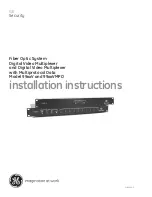
Page 18
8 Dual Measurement Mode
In
Dual Measurement
mode a completely independent but complementary measurement can be
made and displayed on the secondary display. The two independent measurements are actually
made alternately, not simultaneously, and the display update rate for each measurement is
consequently reduced.
Note that this is not the same as
dual display
mode, where both a measurement and a modified
version of that measurement are displayed, e.g. ac Volts and the dB equivalent. In this case only a
single measurement is being made and the measurement rate is unchanged; further information is
given later in this section.
8.1
Dual Measurement Combinations
The full list of dual measurement functions is as follows:
Main Measurement
Secondary Measurement
Vdc
Vac, Idc, Iac
Vac
Vdc, Idc, Iac, Hz
Vdc + Vac
Vdc, Vac, Hz
dB
Vdc, Idc, Iac, Hz
Idc
Vdc, Vac, Iac
Iac
Vdc, Vac, Idc, Hz
Idc + Iac
Idc, Iac, Hz
Hz
Vac, Iac
The parameter for the secondary display is selected by pressing
[2nd]
followed by the chosen
measurement parameter. The secondary display parameter must be selected after the main
parameter has been set. Pressing an illegal parameter will cause a warning double beep and
the key entry will be ignored
Capacitance,
:
, and Continuity/Diode check cannot meaningfully be combined with other
measurements and are therefore always excluded from the secondary display. Vac+Vdc and
Iac+Idc are also excluded because they already involve dual measurements; when they are
being used no secondary display can be set.
The secondary measurement, with the exception of the 10A current ranges, always auto-
ranges. The 10A current ranges are set by first selecting the function (
[2nd]
followed by
[Iac]
or
[Idc]
) then pressing
[2nd]
followed by
[
ଢ଼
]
. To return to the mA measurement select
[2nd]
followed by
[v]
. However, if both main and secondary displays are making current
measurements, the range of the secondary measurement is always that of the main display.
If Vdc and Vac are the two measurement functions, auto-ranging of the secondary display is
restricted such that the dc measurement range is not lower than the ac range; this ensures that
the dc measurement is not affected by a high ac signal, see the table within the Specification
section 19
.
For example, if the main display is set to 10Vdc the secondary display can auto-range between
the 100mV, 1000mV and 10Vac ranges. In this example, low levels of ripple could be measured
(on the 100mV range) on a 10Vdc supply rail, but an ac input >12V will cause the secondary
display to show Overload
{OFL}
warning the user to select a higher main display dc range such
that the secondary ac measurement is in range. Similarly, if the main display is set to 100Vac
then the secondary display will not auto-range below 100Vdc, even for small dc inputs.
When frequency is selected for the secondary display the measurement is made using the ac
range set in the main display. This presents no problems if the main display is in auto-range but
if a higher range has been set manually, such that the reading is less than 5% of the range
maximum, the signal level may not be adequate for frequency measurement.
















































